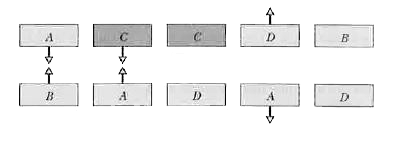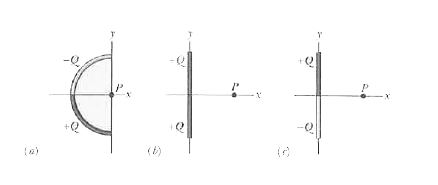Complete Solutions to Check points of chapter ELECTRIC CHARGES AND FIELDS of Class 12 book with complete answers and questions
| Class 12 | PHYSICS |
| Chapter | ELECTRIC CHARGES AND FIELDS |
| RESNICK AND HALLIDAY | Check points |
| Number Of Questions | 9 |
| Academic Year | 2023-24 |
The figure shows five pairs of plates : A, B and D are charged plastic plates and C is an electrically neutral copper plate. The electrostatic forces between the pairs of plates are shown for three of the pairs. For the remaining two pairs, do the plates repel or attract each other ?

View SolutionThe figure shows two protons (symbol p) and one electron (symbol e) on an axis. On the central proton, what is the direction of (a) the force due to the electron, (b) the force due to the other proton, and (c ) the net force ?

View SolutionThe figure here shows three arrangements of an electron e and two protons p. (a) Rank the arrangement according to the magnitude of the net electrostatic force on the electron due to the protons, largest first. (b) In situation c, is the angle between the net force on the electron and the line labelled d less than or more than `45^(@)` ?

View SolutionAssume that charges were initially different. If the charges on them were equally distributed would the angle of divergence increase, decrease, or stay the same ?
View SolutionInitially, sphere A has a charge of -50 e and sphere B has a charge of +20e. The sphere are made of conducting material and are identical in size. If the spheres then touch, when is the resulting charge on sphere A?
View SolutionThe figure here shows a proton p and an electron e on x axis. What is the direction of the electric field due to the electron at (a) point S and (b) point R ? What is the direction of the net electric field at (c ) point R and (d) point S?

View SolutionThe figure here shows three nonconducting rods, one circular and two straight. Each has a uniform charge of magnitude Q along its top half and another along its bottom half. For each rod, what is the direction of the net electric field at point P ?

View Solution(a) In the figure, what is the direction of the electrostatic force on the electrone due to the external electric field shown ? (b) In which direction will the electron accelerate if it is moving parallel to the y axis before it encounters the external field ? (c ) If, instead the electron is initially moving rightward, will its speed increase, decrease, or remain constant ?

View Solution(Fig. 3.95) shows four orientations of an electric dipole in an external electric field. Rank the orientations acording to the
a. magnitude of the torque on the dipole, and
b. potential energy of the dipole, greatest first.
 .
.
View Solution
Check points questions and complete solutions for chapter ELECTRIC CHARGES AND FIELDS of RESNICK AND HALLIDAY PHYSICS (HINGLISH) of Class 12